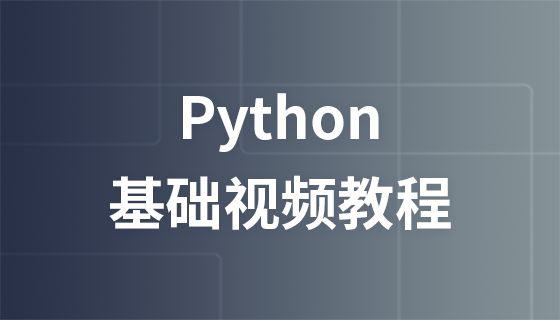
【相关学习推荐:python教程】
实验环境
1.安装Python 3.7
2.安装requests, bs4,pymysql 模块
实验步骤1.安装环境及模块
可参考https://www.jb51.net/article/194104.htm
2.编写代码
# 51cto 博客页面数据插入mysql数据库 # 导入模块 import re import bs4 import pymysql import requests # 连接数据库账号密码 db = pymysql.connect(host='172.171.13.229', user='root', passwd='abc123', db='test', port=3306, charset='utf8') # 获取游标 cursor = db.cursor() def open_url(url): # 连接模拟网页访问 headers = { 'user-agent': 'Mozilla/5.0 (Windows NT 10.0; WOW64) AppleWebKit/537.36 (KHTML, like Gecko) ' 'Chrome/57.0.2987.98 Safari/537.36'} res = requests.get(url, headers=headers) return res # 爬取网页内容 def find_text(res): soup = bs4.BeautifulSoup(res.text, 'html.parser') # 博客名 titles = [] targets = soup.find_all("a", class_="tit") for each in targets: each = each.text.strip() if "置顶" in each: each = each.split(' ')[0] titles.append(each) # 阅读量 reads = [] read1 = soup.find_all("p", class_="read fl on") read2 = soup.find_all("p", class_="read fl") for each in read1: reads.append(each.text) for each in read2: reads.append(each.text) # 评论数 comment = [] targets = soup.find_all("p", class_='comment fl') for each in targets: comment.append(each.text) # 收藏 collects = [] targets = soup.find_all("p", class_='collect fl') for each in targets: collects.append(each.text) # 发布时间 dates=[] targets = soup.find_all("a", class_='time fl') for each in targets: each = each.text.split(':')[1] dates.append(each) # 插入sql 语句 sql = """insert into blog (blog_title,read_number,comment_number, collect, dates) values( '%s', '%s', '%s', '%s', '%s');""" # 替换页面 \xa0 for titles, reads, comment, collects, dates in zip(titles, reads, comment, collects, dates): reads = re.sub('\s', '', reads) comment = re.sub('\s', '', comment) collects = re.sub('\s', '', collects) cursor.execute(sql % (titles, reads, comment, collects,dates)) db.commit() pass # 统计总页数 def find_depth(res): soup = bs4.BeautifulSoup(res.text, 'html.parser') depth = soup.find('li', class_='next').previous_sibling.previous_sibling.text return int(depth) # 主函数 def main(): host = "https://blog.51cto.com/13760351" res = open_url(host) # 打开首页链接 depth = find_depth(res) # 获取总页数 # 爬取其他页面信息 for i in range(1, depth + 1): url = host + '/p' + str(i) # 完整链接 res = open_url(url) # 打开其他链接 find_text(res) # 爬取数据 # 关闭游标 cursor.close() # 关闭数据库连接 db.close() if __name__ == '__main__': main()
3..MySQL创建对应的表
CREATE TABLE `blog` ( `row_id` int(11) NOT NULL AUTO_INCREMENT COMMENT '主键', `blog_title` varchar(52) DEFAULT NULL COMMENT '博客标题', `read_number` varchar(26) DEFAULT NULL COMMENT '阅读数量', `comment_number` varchar(16) DEFAULT NULL COMMENT '评论数量', `collect` varchar(16) DEFAULT NULL COMMENT '收藏数量', `dates` varchar(16) DEFAULT NULL COMMENT '发布日期', PRIMARY KEY (`row_id`) ) ENGINE=InnoDB AUTO_INCREMENT=1 DEFAULT CHARSET=utf8;

4.运行代码,查看效果:
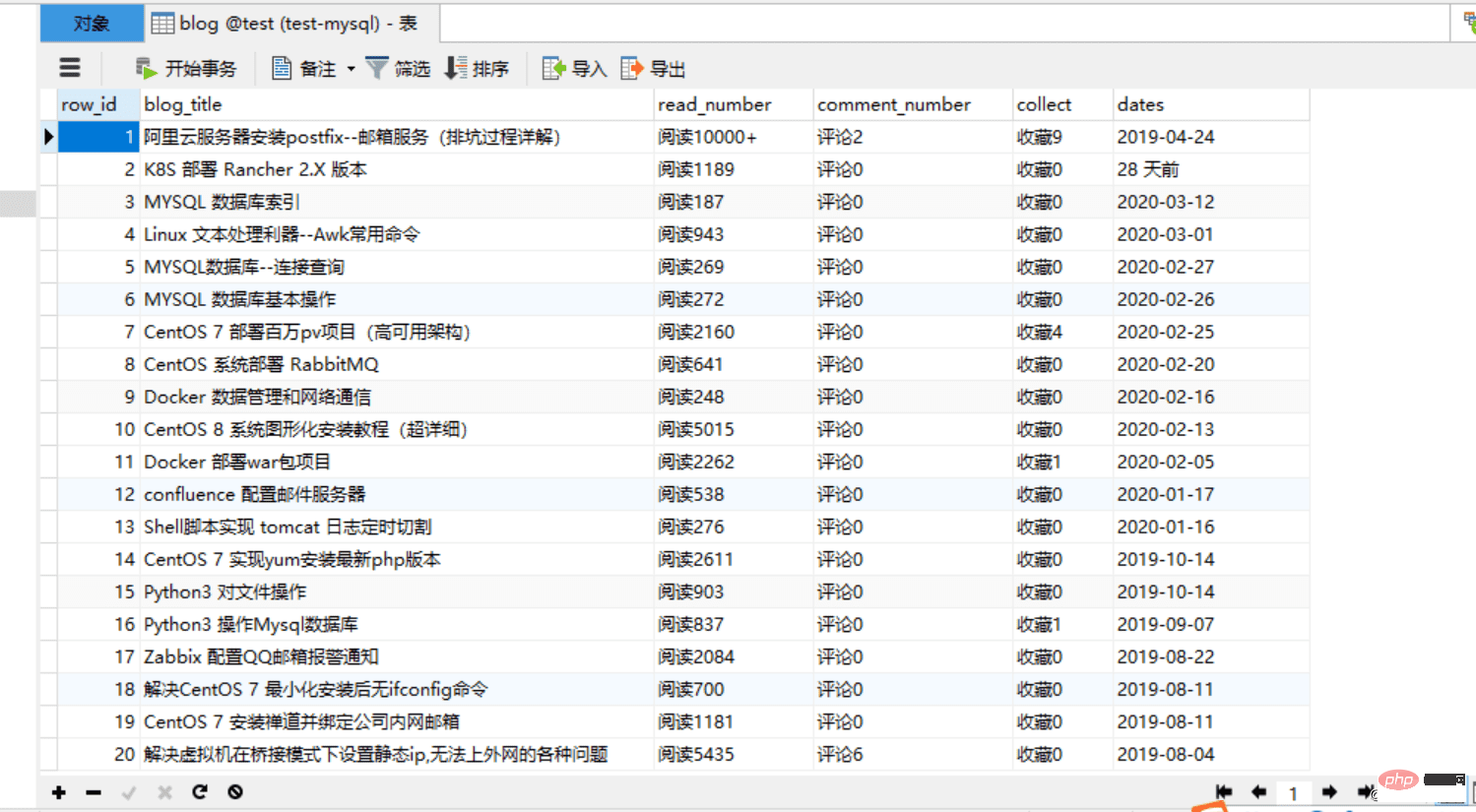
改进版:
改进内容:
1.数据库里面的某些字段只保留数字即可
2.默认爬取的内容都是字符串,存放数据库的某些字段,最好改为整型,方便后面数据库操作
1.代码如下:
import re import bs4 import pymysql import requests # 连接数据库 db = pymysql.connect(host='172.171.13.229', user='root', passwd='abc123', db='test', port=3306, charset='utf8') # 获取游标 cursor = db.cursor() def open_url(url): # 连接模拟网页访问 headers = { 'user-agent': 'Mozilla/5.0 (Windows NT 10.0; WOW64) AppleWebKit/537.36 (KHTML, like Gecko) ' 'Chrome/57.0.2987.98 Safari/537.36'} res = requests.get(url, headers=headers) return res # 爬取网页内容 def find_text(res): soup = bs4.BeautifulSoup(res.text, 'html.parser') # 博客标题 titles = [] targets = soup.find_all("a", class_="tit") for each in targets: each = each.text.strip() if "置顶" in each: each = each.split(' ')[0] titles.append(each) # 阅读量 reads = [] read1 = soup.find_all("p", class_="read fl on") read2 = soup.find_all("p", class_="read fl") for each in read1: reads.append(each.text) for each in read2: reads.append(each.text) # 评论数 comment = [] targets = soup.find_all("p", class_='comment fl') for each in targets: comment.append(each.text) # 收藏 collects = [] targets = soup.find_all("p", class_='collect fl') for each in targets: collects.append(each.text) # 发布时间 dates=[] targets = soup.find_all("a", class_='time fl') for each in targets: each = each.text.split(':')[1] dates.append(each) # 插入sql 语句 sql = """insert into blogs (blog_title,read_number,comment_number, collect, dates) values( '%s', '%s', '%s', '%s', '%s');""" # 替换页面 \xa0 for titles, reads, comment, collects, dates in zip(titles, reads, comment, collects, dates): reads = re.sub('\s', '', reads) reads=int(re.sub('\D', "", reads)) #匹配数字,转换为整型 comment = re.sub('\s', '', comment) comment = int(re.sub('\D', "", comment)) #匹配数字,转换为整型 collects = re.sub('\s', '', collects) collects = int(re.sub('\D', "", collects)) #匹配数字,转换为整型 dates = re.sub('\s', '', dates) cursor.execute(sql % (titles, reads, comment, collects,dates)) db.commit() pass # 统计总页数 def find_depth(res): soup = bs4.BeautifulSoup(res.text, 'html.parser') depth = soup.find('li', class_='next').previous_sibling.previous_sibling.text return int(depth) # 主函数 def main(): host = "https://blog.51cto.com/13760351" res = open_url(host) # 打开首页链接 depth = find_depth(res) # 获取总页数 # 爬取其他页面信息 for i in range(1, depth + 1): url = host + '/p' + str(i) # 完整链接 res = open_url(url) # 打开其他链接 find_text(res) # 爬取数据 # 关闭游标 cursor.close() # 关闭数据库连接 db.close() #主程序入口 if __name__ == '__main__': main()
2.创建对应表
CREATE TABLE `blogs` ( `row_id` int(11) NOT NULL AUTO_INCREMENT COMMENT '主键', `blog_title` varchar(52) DEFAULT NULL COMMENT '博客标题', `read_number` int(26) DEFAULT NULL COMMENT '阅读数量', `comment_number` int(16) DEFAULT NULL COMMENT '评论数量', `collect` int(16) DEFAULT NULL COMMENT '收藏数量', `dates` varchar(16) DEFAULT NULL COMMENT '发布日期', PRIMARY KEY (`row_id`) ) ENGINE=InnoDB AUTO_INCREMENT=1 DEFAULT CHARSET=utf8;
3.运行代码,验证
升级版
为了能让小白就可以使用这个程序,可以把这个项目打包成exe格式的文件,让其他人,使用电脑就可以运行代码,这样非常方便!
1.改进代码:
#末尾修改为: if __name__ == '__main__': main() print("\n\t\t所有数据已成功存放数据库!!! \n") time.sleep(5)
2.安装打包模块pyinstaller(cmd安装)
pip install pyinstaller -i https://pypi.tuna.tsinghua.edu.cn/simple/
3.Python代码打包
1.切换到需要打包代码的路径下面
2.在cmd窗口运行 pyinstaller -F test03.py (test03为项目名称)
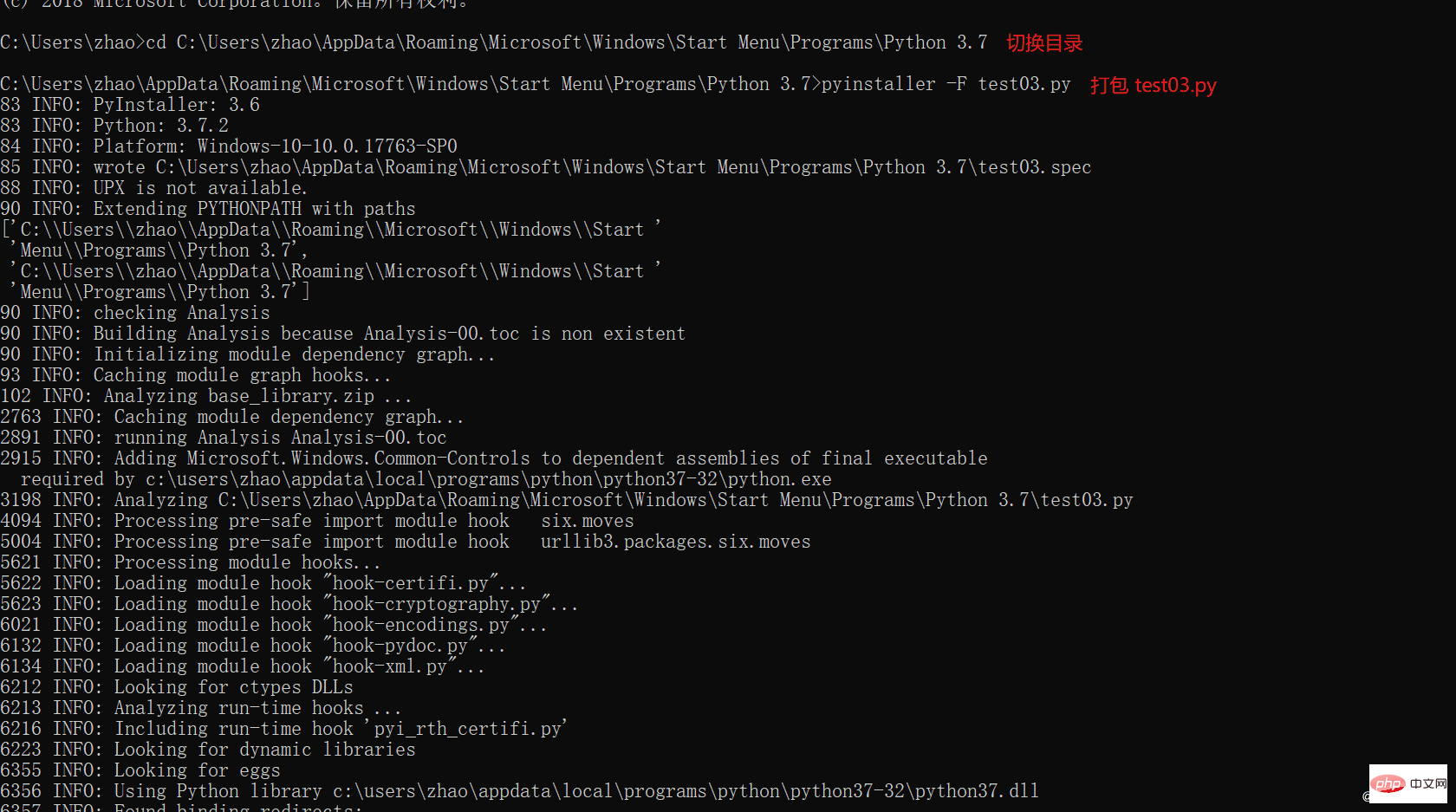
4.查看exe包
在打包后会出现dist目录,打好包就在这个目录里面

5.运行exe包,查看效果
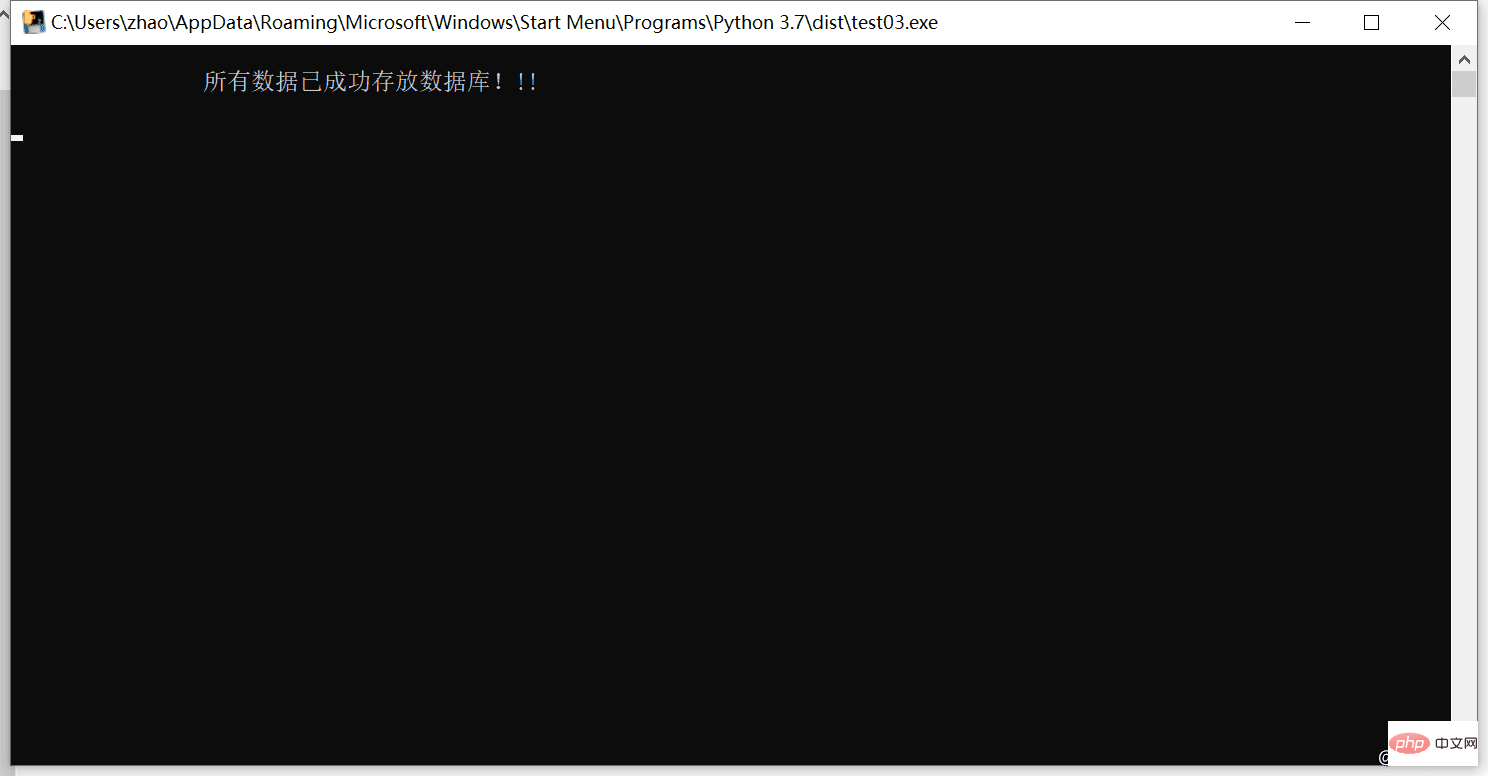
检查数据库
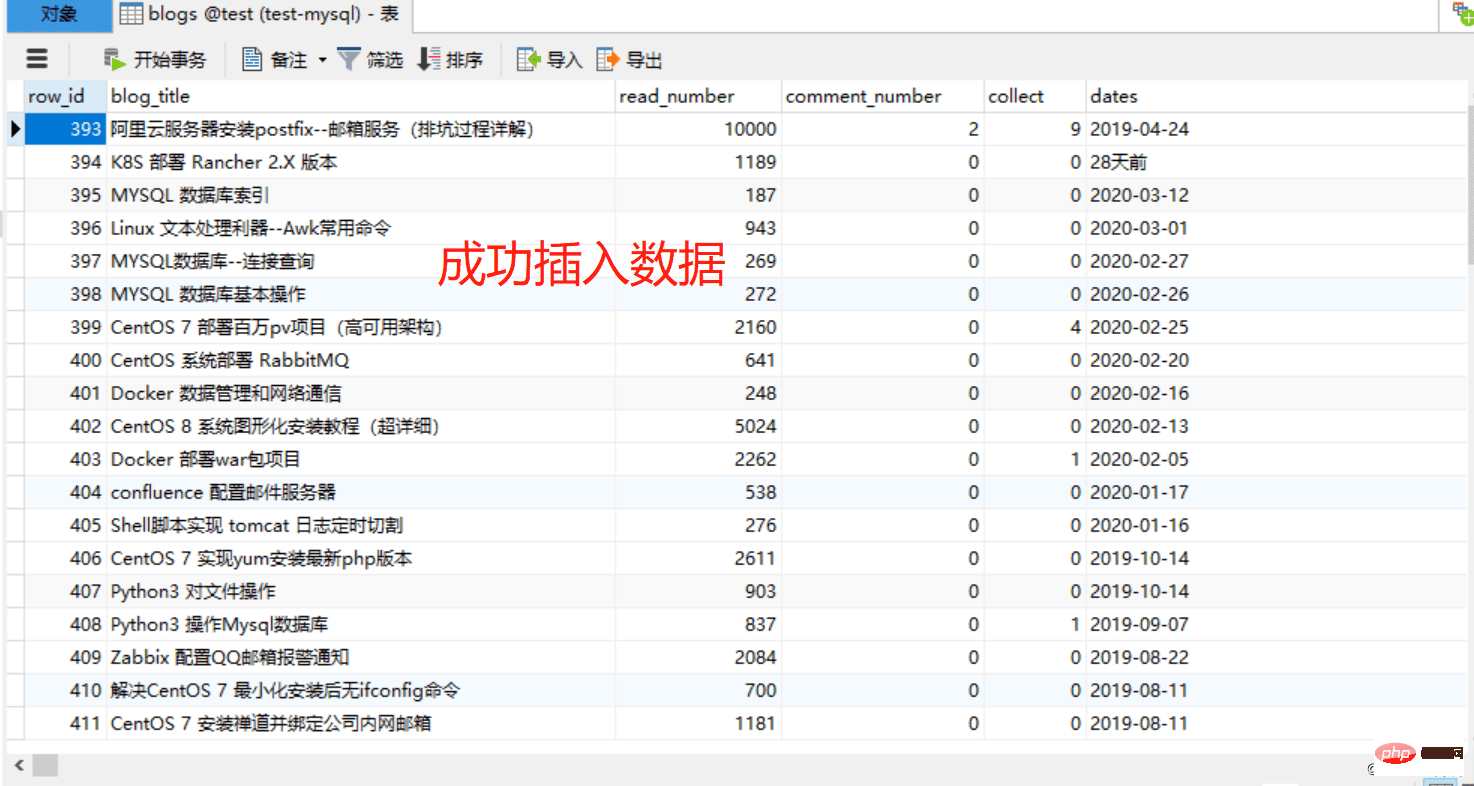
相关学习推荐:mysql教程
以上是Python爬取51cto数据并存入MySQL方法详解的详细内容。更多信息请关注PHP中文网其他相关文章!

